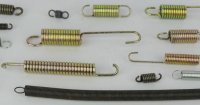拉伸弹簧的装配技巧
拉伸弹簧是一种常见的机械装置,它通常用于各种工业应用中。在生产和制造过程中,正确地装配拉伸弹簧是至关重要的。本文将介绍一些拉伸弹簧的装配技巧,以确保其正常运作并提高其寿命。
1. 选择适当的工具
在装配拉伸弹簧之前,确保您使用适当的工具。这些工具包括弹簧钳、弹簧专用装配工具和安全手套。弹簧钳可以帮助您更容易地操控弹簧,并确保正确安装。弹簧专用装配工具可以提供额外的帮助和支持,确保安装过程更为顺利。同时,佩戴安全手套是非常必要的,以防止受伤。
2. 准备工作
在装配拉伸弹簧之前,确保您已经完成了准备工作。这包括清洁和检查弹簧及其安装位置。确保弹簧表面没有任何污垢或损坏,并检查安装位置是否符合设计要求。如果发现任何问题或缺陷,应及时予以处理。
3. 弹簧的正确安装方向
在装配拉伸弹簧时,确保安装方向正确。弹簧通常具有不同的两端,一端可能会有钩型设计或杆状设计。安装时,确保正确的一端连接到正确的位置,以确保弹簧能够正常工作。
4. 使用适当的力度
装配拉伸弹簧时,确保使用适当的力度。过度应力或不足的应力都可能导致弹簧失去弹性或功能。使用弹簧专用装配工具可以帮助您控制力度,确保弹簧能够正确安装而不受损。
5. 防止过度拉伸
一些拉伸弹簧可能需要进行预拉伸以达到正确的工作状态。然而,过度拉伸会导致弹簧永久性变形或破裂。在装配拉伸弹簧时,确保遵循制造商提供的正确拉伸量。如果需要进行预拉伸,请使用适当的工具和技术来保证其正确性。
6. 检查安装质量
装配拉伸弹簧后,务必检查安装质量。确保弹簧安装位置正确且稳固,没有松动或脱落的迹象。同时,确保弹簧的工作状态正常,并满足预期的要求。如果发现任何问题,应及时对其进行调整或更换。
7. 安全注意事项
在装配拉伸弹簧时,请始终确保安全。佩戴安全手套,避免使用过大的力量,以免造成伤害。如果弹簧具有高压或高张力,请确保使用合适的工具和技术来操作。
结论
正确的装配拉伸弹簧对于其正常运作十分重要。通过选择适当的工具、准备工作、正确的安装方向、适当的力度以及防止过度拉伸,可以确保拉伸弹簧的寿命和性能。
希望本文提供的拉伸弹簧装配技巧能帮助您在工业应用中正确安装和使用拉伸弹簧。通过遵循这些技巧,您可以减少故障和损坏,并提高设备的可靠性和安全性。
感谢您阅读本文,希望对您有所帮助。
Translated to English: htmlAssembly Techniques for Tension Springs
Tension springs are common mechanical devices that are typically used in various industrial applications. Properly assembling tension springs is crucial during the production and manufacturing process. This article will introduce some assembly techniques for tension springs to ensure their proper operation and extend their lifespan.
1. Use the Right Tools
Prior to assembling tension springs, make sure you have the appropriate tools on hand. These tools include spring pliers, specialized assembly tools for springs, and safety gloves. Spring pliers can help you manipulate the springs more easily and ensure proper installation. Specialized assembly tools for springs can provide additional assistance and support, making the installation process smoother. Additionally, wearing safety gloves is essential to prevent injuries.
2. Preparation
Before assembling tension springs, ensure that you have completed the necessary preparation work. This includes cleaning and inspecting the springs as well as their installation location. Make sure the spring surfaces are free from any dirt or damage, and inspect the installation location to ensure it meets the design requirements. If any issues or defects are found, they should be addressed promptly.
3. Proper Installation Orientation
When assembling tension springs, ensure that the installation orientation is correct. Springs typically have different ends, with one end possibly having a hook-shaped design or a rod-shaped design. When installing, make sure the correct end is connected to the appropriate position to ensure the spring functions properly.
4. Apply the Right Force
When assembling tension springs, ensure that you apply the appropriate force. Excessive or insufficient force can both lead to the spring losing its elasticity or functionality. Using specialized assembly tools for springs can help you control the force applied, ensuring the spring is properly installed without being damaged.
5. Prevent Overstretching
Some tension springs may require pre-stretching to achieve the desired working state. However, overstretching can result in permanent deformation or breakage of the spring. When assembling tension springs, make sure to follow the manufacturer's recommended stretching amount. If pre-stretching is necessary, use the appropriate tools and techniques to ensure its accuracy.
6. Check the Quality of Installation
After assembling tension springs, it is essential to check the quality of the installation. Ensure that the springs are correctly and securely installed, without any signs of loosening or detachment. Additionally, ensure that the springs are functioning properly and meeting the expected requirements. If any issues are detected, they should be promptly adjusted or replaced.
7. Safety Precautions
Always prioritize safety when assembling tension springs. Wear safety gloves and avoid using excessive force to prevent injuries. If the spring has high pressure or tension, make sure to use appropriate tools and techniques for handling.
Conclusion
Proper assembly of tension springs is crucial for their normal operation. By utilizing the right tools, performing necessary preparation work, ensuring proper installation orientation, applying the correct force, and preventing overstretching, the lifespan and performance of tension springs can be optimized.
We hope that the assembly techniques provided in this article will assist you in correctly installing and utilizing tension springs in industrial applications. By following these techniques, you can reduce failures and damages while enhancing the reliability and safety of your equipment.
Thank you for reading this article, and we hope it has been helpful to you.

 89
89 2023-08-11 13:46
2023-08-11 13:46 admin
admin
